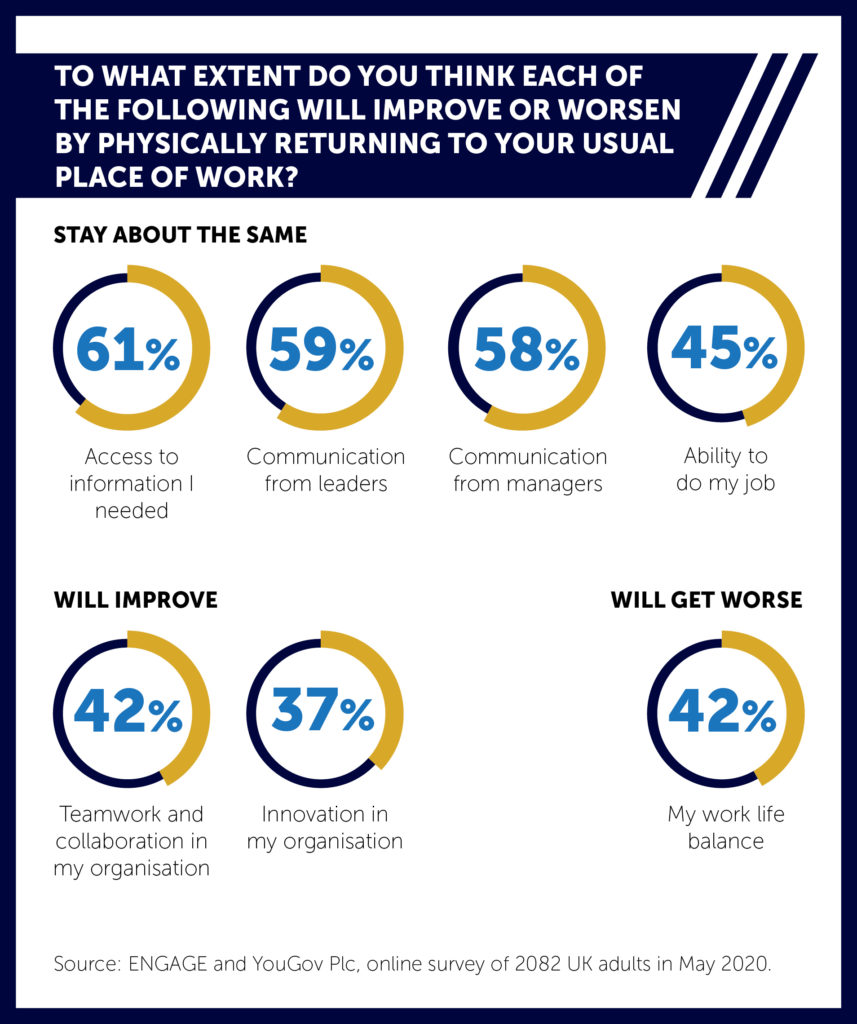Future of Work and People Strategy
Hybrid Working: The Good, the Bad and the Ugly
Hybrid working has found its way into the global vernacular since 2020, and it’s clear that it has no intention of leaving anytime soon. The Covid-19 pandemic ignited a mass social experiment in which everyone had to work from home between May and December 2020 in order to curb the spread of the novel disease.
In the post-pandemic world, the hybrid model, which merges pre-Covid-19 patterns of office-based working with remote days, allowing both in-person collaboration, but also greater flexibility and the opportunity for focused work at home, has been the dominant approach for most organisations. Novartis, Microsoft and Deutsche Bank AG are just a few companies that have announced this is how they plan to work in the future.
In one Accenture study carried out in May 2021, 83% said they wanted to go hybrid after the pandemic. In theory, it might appear that hybrid working offers the best deal for both employer and employee. However, like most new work practices, the pain points inevitably begin to rear their ugly heads, as there is no one size fits all approach in such a diverse global business environment.
The post-Covid statistics
There are five approaches that make up a hybrid workplace: full time in the office, fixed ratio mix of in and out of office, in-office with some home, at-home with some office, and full time at home. Describing hybrid teams as in-office or at-home doesn’t reflect the true nature and nuances of location and time – it’s more accurately described as dispersed and co-located. So, what are organisations currently doing?
- 16% of companies globally are fully remote. (Owl Labs)
- 73% of employees want flexible remote work options to stay. (Microsoft)
- 57% of British workers want to be able to work from home. (YouGov)
- Women with child-care needs are 32% less likely to leave their job if they can work remotely. (Catalyst)
- As of February 2021, 6.9% of Indeed job postings cited remote work as an option, compared with 2.9% in January 2020. (Indeed)
- 22% of all full workdays will be supplied from home after the pandemic ends, compared with just 5% before. (BFI)
The Good
Regardless of the approach, the argument against hybrid work boils down to these main claims; the reduction of productivity, culture will suffer, innovation won’t flourish, and hybrid work is inherently unfair for certain customer-facing roles and industries.
However, for most of these claims, research suggests otherwise. Firstly, as expected, the stigma associated with working from home has diminished during Covid-19. Pre-pandemic, working from home historically appeared to carry the view that employees “shirk” instead of work when they are not present in the office. Fast forward to today, in a recent study, a large majority of respondents reported that perceptions about working from home have improved since the start of the pandemic among people they know. The recent findings on productivity might be the main reason.
A survey drawing upon the views of almost 4,000 business and HR leaders, found that remote and hybrid working has provided a short-term productivity boost in most workplaces. Fifty-seven percent of respondents said their organisation performed better against workforce performance and productivity targets over the past 12 months, compared to a mere 4% saying their company performed significantly worse in that time.
Most advanced global organisations recognise the ample benefits of hybrid working, such as, improved work life balances and wellbeing, reducing their carbon footprint and better productivity. It is no surprise that fewer than four in ten workers want to return to the office full time.

The Bad
Conversely, research also suggests that constantly switching workplaces, and the logistics associated with it, can leave employees drained. Many workers report that hybrid working is emotionally draining. A recent global study by employee engagement platform Tinypulse, showed that more than 80% of people leaders reported that such a set-up was exhausting for employees. Constantly changing government guidance around working from home may also add to this exhaustion.
Furthermore, as working from home is increasingly being seen as a perk, generally higher earning, highly educated workers will enjoy the benefits of hybrid working disproportionately. Organisations with mixed workforces must start to consider equity of treatment in order to create fairness in the work environment.
How to Curb ‘The Ugly’
So how do we overcome some of these challenges?
- Keeping remote workers connected with those in the office – investing in the right technology to enableseamless communication is essential.This can include using the right digital tools to support meetings for both in person and remote workers.
- Equal treatment for remote employees – managers must ensure equality between remote and in-person performance management, by giving the same opportunities for development and progression.
- The value of engagement and work relationships – forming good working relationships is crucial for employees to build engagement and productivity. Since the physical separation of staff in hybrid models can make this difficult, scheduling in all team social days or away days, can be especially valuable.
- The new role of the office – organisation must reconsider how they use their office space and re-design their offices to support their desired ways of working.
- Maintain the culture with a dispersed workforce – organisations must review and adapt their target culture. Since the meaning of culture has changed significantly in the hybrid environment, it is a time for organisations to decide which aspects they can nurture, and which they can potentially let go.
- Maintain open communication lines – organisations must encourage frequent informal and in-person-communication to prevent silos forming between teams or between remote and in-office workers.
- Continue supporting employee mental and physical health – organisations have boosted their focus on mental and physical health in response to workers feeling that remote work has negatively impacted their wellbeing. Managers must check-in frequently and organisations must provide managers with the skills needed to identify if anyone in their team is struggling.
A consistent experience for all employees seems to be the overriding challenge for the hybrid working model. Organisations must address these challenges if they plan to implement a successful hybrid model in the long-term, regardless of whether they work in the office or remotely. If this is a topic of interest, our Post Meeting Notes from the event titled The Realities of the New Working Environment, are available here. This session explored the strategies that organisations are adopting to implement effective hybrid working and how they are resolving the challenges inherent to new working models.
RECENT POST MEETING NOTES:
The Realities of the New Working Environment
The CRF research associated with this event is sponsored by Bird & Bird, BTS and Mercer.




